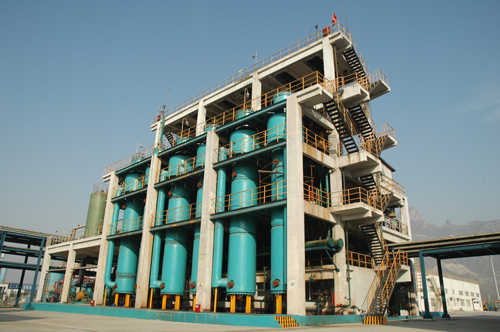The chlor-alkali industry refers to the production of basic chemical products including caustic soda, polyvinyl chloride and chlorine as significant chemical raw materials.
According to CRI, China is a leading power of the production capacity and volume of caustic soda, polyvinyl chloride and chlorine in the globe.
Up to the end of 2015, the number of existing caustic soda manufacturers was 163 and the total production capacity was 38.73 million tons per year with an increase of 28.2% compared to that of 2010 in China, of which the production capacity of ion-exchange membrane was 38.18 million tons with a proportion of about 98.6%. Caustic soda manufacturers mainly concentrate in Shandong, Jiangsu, Inner Mongolia, Xinjiang, Henan and Zhejiang with an aggregate production capacity proportion of 61.5% of the total.
There were 81 operating polyvinyl chloride manufacturers with a total production capacity of 23.48 million tons per year, of which the calcium carbide method was 19.18 million tons with a proportion of about 81.7% of the total by the end of 2015. Major production capacity was distributed in Inner Mongolia, Shandong, Tianjin, Shaanxi and Henan with an aggregate proportion of 62.2% of the total.
The chlor-alkali industry transfers in terms of development trend and structural problems for the slump growth rate of economy in China and the international financial crisis in 2008.
In recent years, the production capacity of new caustic soda and PVC experienced a significant growth with the rapid development and project investment in various areas. Meanwhile, the downstream consumption increased rapidly and stably while the growth rate was smaller than that of the production capacity with an intensifying overcapacity for the imbalance between supply and demand.
In addition, the production capacity of caustic soda and PVC is surplus and imbalanced in different regions. New expansion of the production capacity of caustic soda is to balance chlorine resources.
However, the production capacity of major auxiliary chlorine consuming products is surplus such as methane chloride, epichlorohydrin, chlorine-containing aromatic products, chloroethanoic acid, chlorinated paraffin, trichlorosilane, trichloroethylene and tetrachloroethylene. Central and western regions are major supply areas of caustic soda and PVC while eastern and southern regions are major consumption ones.
Large amount of PVC and solid caustic soda in central and western regions need to be sold to major consumption areas in east and south China due to the mismatch between the production capacity expansion and the distribution. According to incomplete statistics, the annual production capacity of about 800 million tons of caustic soda and 600 million tons of PVC were phased out of the market from 2011 to 2015.
The concentration rate of the chlor-alkali industry increased in China in recent years. The proportion of the production capacity scale of caustic soda enterprises under 10 million tons per year decreased from 15.4% in 2010 to 9.08% in 2015. The number of enterprises with a production capacity scale of over 40 million tons per year increased from 17 in 2010 to 23 in 2015 and the proportion increased from 27.1% to 37.7%. Meanwhile, the proportion of the production capacity scale of PVC enterprises under 10 million tons per year decreased from 9.4% in 2010 to 4.8% in 2015. The number of enterprises with a production capacity scale of over 40 million tons per year increased from 17 in 2010 to 22 in 2015 and the proportion increased from 45.8% to 55.8%.
According to CRI, the annual export volume of caustic soda was over two million tons from 2011 to 2015 with destinations such as Australia, the U.S.A., Southeast Asia and Africa. PVC is exported to over ten destinations including India, Russia, Southeast Asia and Central Asia. Meanwhile, major export destinations of China PVC include India, Russia, Vietnam, Kazakhstan, Malaysia and Thailand.
In terms of environment protection, the Chlor-Alkali Industry is numerous in product and by-product varieties and discharge of waste water, gas as well as solid wastes, which leading to environment pressure. PVC is the most chlorine-consuming product with a consumption rate of about 40% of national chlorine output volume. Major factor influencing the sustainable development of calcium carbide PVC is the prevention and control of mercury pollution due to the increasingly exhausted mercury resources and the future implementation of international Minamata Convention about Mercury.
Products of the chlor-alkali industry are applied in various fields, and are closely related to national economy. Meanwhile, the annual growth of output volume is closely related to that of GDP. The economy growth rate declined after years’ of rapid increase while it is expected to remain over 6% in the next few years, leading to certain development space of the chlor-alkali industry in China.
Readers can obtain the following information or more through this report:
Overview of Chlor-Alkali Industry in China
Development Environment of Chlor-Alkali Industry in China
Trend of Production Capacity of Chlor-Alkali Industry in China
Development Status of PVC Industry in China
Competition Status of Chlor-Alkali Industry in China
Major Manufacturers of Chlor-Alkali Industry and Their Operation Status in China
Import and Export Status of Chlor-Alkali Industry in China
Price trend of Chlor-Alkali in China
Forecast on Development Trend of Chlor-Alkali Industry in China
Source: https://www.kenresearch.com/manufacturing-and-construction/infrastructure/china-chlor-alkali-industry-overview/47164-97.html
Contact:
Ken Research
Ankur Gupta,
Head Marketing & Communications
query@kenresearch.com
+91-124- 4230204
www.kenresearch.com

